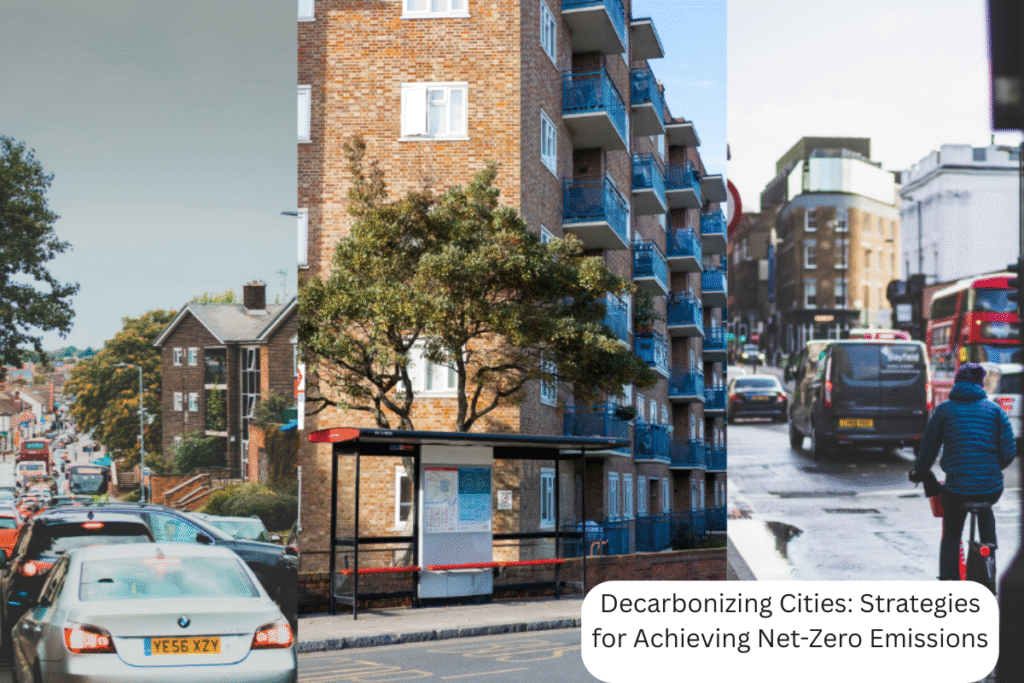
As cities around the world continue to grow, the challenge of reducing carbon emissions becomes more pressing. Cities are responsible for a significant portion of global greenhouse gas emissions, making them crucial players in the fight against climate change. Achieving net-zero emissions in urban areas is essential for meeting global climate targets and creating sustainable, livable environments. In this article, we’ll explore strategies that cities can adopt to decarbonize, reduce emissions, and move towards a net-zero future.
1. Energy Transition: Shifting to Renewable Sources
One of the most effective strategies for decarbonizing cities is transitioning from fossil fuels to renewable energy sources. By investing in solar, wind, hydroelectric, and geothermal energy, cities can drastically reduce their reliance on coal, oil, and natural gas.
Key Actions:
- Increase investment in renewable energy infrastructure: Cities can set up solar panels on rooftops, install wind turbines, and invest in renewable energy storage systems.
- Support decentralized energy systems: Local, community-based renewable energy projects can empower residents and reduce emissions from centralized power plants.
- Encourage renewable energy in new buildings: Mandate or incentivize the use of renewable energy technologies in new construction projects.
Benefits:
- Reduced Carbon Footprint: Renewable energy produces little to no emissions compared to fossil fuels.
- Energy Security: Decentralized energy sources reduce dependency on external fuel supplies.
- Cost Savings: As renewable energy technologies become more affordable, long-term energy costs decrease.
2. Electrification of Transportation
Transportation is one of the largest sources of emissions in cities. Electrifying public transportation, private vehicles, and commercial fleets can significantly reduce emissions and improve air quality.
Key Actions:
- Expand electric vehicle (EV) infrastructure: Build more EV charging stations to make it easier for people to switch to electric vehicles.
- Promote electric public transport: Invest in electric buses, trams, and metro systems to replace diesel-powered transportation.
- Provide incentives for EV adoption: Offer subsidies or tax credits for individuals and businesses to purchase electric vehicles.
Benefits:
- Lower Emissions: Electric vehicles produce fewer emissions than their gas-powered counterparts.
- Improved Public Health: Reducing pollution from vehicles can improve air quality and public health.
- Energy Efficiency: Electric vehicles are more energy-efficient than gasoline or diesel-powered vehicles.
3. Energy-Efficient Buildings and Retrofitting
Buildings account for a significant portion of urban carbon emissions. Retrofitting old buildings and designing new ones to be energy-efficient is an essential strategy for reducing emissions in cities.
Key Actions:
- Mandate energy-efficient building codes: Implement building regulations that require energy-saving measures, such as high-efficiency insulation, windows, and heating systems.
- Promote green building certifications: Encourage the construction of buildings that meet green standards, such as LEED or BREEAM certifications.
- Retrofit existing buildings: Provide financial incentives for homeowners and businesses to retrofit old buildings with energy-efficient technologies.
Benefits:
- Lower Energy Consumption: Energy-efficient buildings use less power, reducing overall energy demand.
- Cost Savings: Over time, energy-efficient buildings can lead to lower utility bills and operating costs.
- Comfort and Health: Well-insulated buildings maintain better indoor air quality and comfort.
4. Urban Green Spaces and Nature-Based Solutions
Increasing urban green spaces and integrating nature-based solutions can help cities absorb carbon, improve air quality, and reduce the heat island effect, making them more resilient to climate change.
Key Actions:
- Develop green roofs and walls: These can reduce the urban heat island effect and increase biodiversity in city centers.
- Increase urban forests and parks: Trees and vegetation absorb carbon dioxide and provide natural cooling.
- Create permeable surfaces: Replace asphalt and concrete with permeable materials to allow better water absorption and reduce runoff.
Benefits:
- Carbon Sequestration: Plants and trees absorb carbon dioxide from the atmosphere.
- Improved Urban Resilience: Green spaces help manage stormwater and reduce the risk of flooding.
- Enhanced Quality of Life: Urban greenery improves mental health and provides spaces for recreation and relaxation.
5. Circular Economy and Waste Management
A circular economy aims to reduce waste, reuse resources, and keep products in use for as long as possible. Implementing circular economy principles in cities can significantly reduce emissions associated with waste and resource consumption.
Key Actions:
- Encourage recycling and composting: Increase waste diversion through robust recycling programs and composting initiatives.
- Promote sustainable product design: Encourage businesses to design products with longevity, repairability, and recyclability in mind.
- Reduce food waste: Implement food waste reduction initiatives at the city level to cut emissions from landfills.
Benefits:
- Reduced Waste: By diverting waste from landfills, cities can lower methane emissions.
- Resource Conservation: A circular economy reduces the need for raw materials, conserving natural resources.
- Economic Opportunity: Circular economy initiatives can create new jobs in recycling, upcycling, and repair industries.
6. Policy and Community Engagement
A successful transition to net-zero emissions requires collaboration between governments, businesses, and communities. Strong policies, regulations, and community engagement are essential for driving systemic change.
Key Actions:
- Set ambitious carbon reduction targets: Cities should set clear and measurable targets for emissions reductions.
- Engage communities in climate action: Educate residents on the importance of reducing emissions and provide them with the tools to take action.
- Incentivize businesses to adopt sustainable practices: Offer tax incentives or grants to companies that implement carbon-reducing technologies.
Benefits:
- Inclusive Solutions: Engaging all sectors of society ensures that solutions are equitable and effective.
- Accountability: Clear policies help track progress and hold parties accountable for meeting emissions targets.
- Accelerated Action: Well-designed policies can provide the necessary incentives to speed up the decarbonization process.
FAQs
1. What is decarbonization, and why is it important for cities?
Decarbonization refers to the process of reducing carbon emissions, particularly from fossil fuel consumption. It is important for cities because they are major contributors to global emissions. Achieving net-zero emissions in urban areas is vital to mitigating climate change and promoting sustainable development.
2. How can cities encourage electric vehicle adoption?
Cities can encourage electric vehicle adoption by expanding charging infrastructure, offering financial incentives such as tax credits, and promoting policies that support EVs in public transportation.
3. What role do green spaces play in decarbonizing cities?
Green spaces like parks and urban forests absorb carbon dioxide and provide cooling, which helps reduce the overall carbon footprint of cities. They also offer other benefits, such as improving public health and increasing biodiversity.
4. What is the circular economy, and how does it help reduce emissions?
A circular economy focuses on reducing waste and reusing resources. By promoting recycling, reusing materials, and designing products for longevity, cities can reduce emissions associated with resource extraction and waste disposal.
5. What can individuals do to help decarbonize their city?
Individuals can contribute by reducing energy consumption, using public transportation or electric vehicles, recycling, and supporting sustainable businesses and policies. Collective action at the individual level can make a significant impact.
Conclusion
Decarbonizing cities is a complex but achievable goal. By adopting strategies like transitioning to renewable energy, electrifying transportation, enhancing energy efficiency, promoting green spaces, and embracing circular economy practices, cities can significantly reduce their carbon footprints. With strong policies, community engagement, and innovation, urban areas can lead the way toward a sustainable, net-zero future, benefiting both the environment and the people who live in them.
